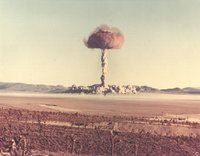Radiation Exposure Compensation Act of 1990, United States
Through enactment of the Radiation Exposure Compensation Act (RECA) of 1990, the federal government sought to compensate individuals who had developed diseases due to unintended exposure to radiation from atomic testing fallout. U.S. Congress established conditions for compensation, including a payout date of January 10, 2001, and a list of compensable cancers. The Act also authorized the appropriation of monetary sums necessary for each of the fiscal years 2000 through 2009 for the Department of Health and Human Services (HHS) to give grants to states to combat radiogenic cancers and diseases.
RECA acknowledges five categories of claimants: uranium miners, uranium millers, ore transporters, downwinders, and onsite nuclear-test participants. Each group of claimants had very specific burdens of proof placed upon them, in order to show the affect that radiation had on them.
Within the Act, Congress inserted an apology on behalf of the nation to individuals affected by radiation testing and their families. They also specified that the Act would terminate either when funds expired or after twenty-two years.
Further Reading
Radiation Exposure and Compensation: Pending Legislation (National Cancer Institute)
Cost Estimate for RECA Amendments of 1999 (Congressional Budget Office)
Assessment of Scientific Information for the Radiation Exposure Screening and Education Program (National Academic Press)
Radiation Exposure Compensation Act: Full Text (George Washington University)
